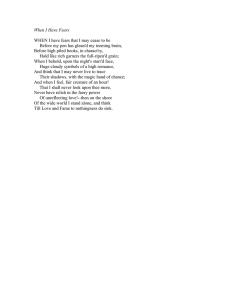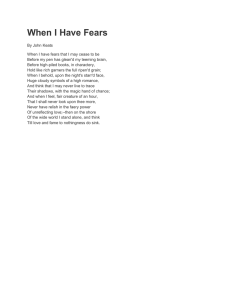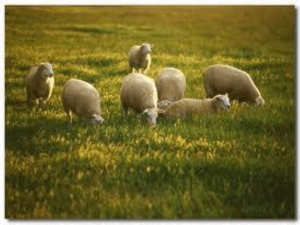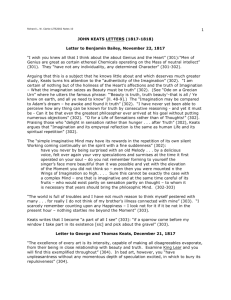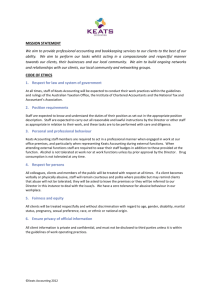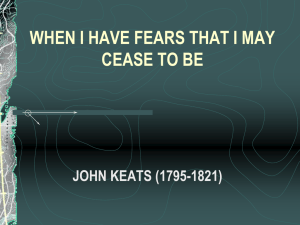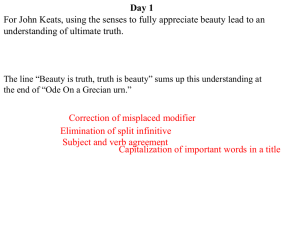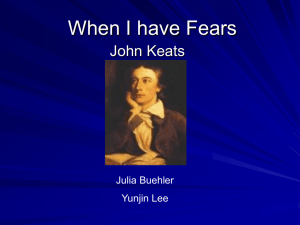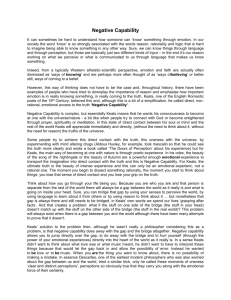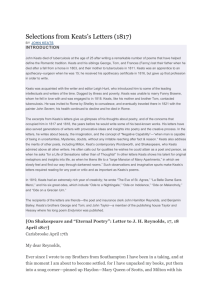When i have fears
advertisement
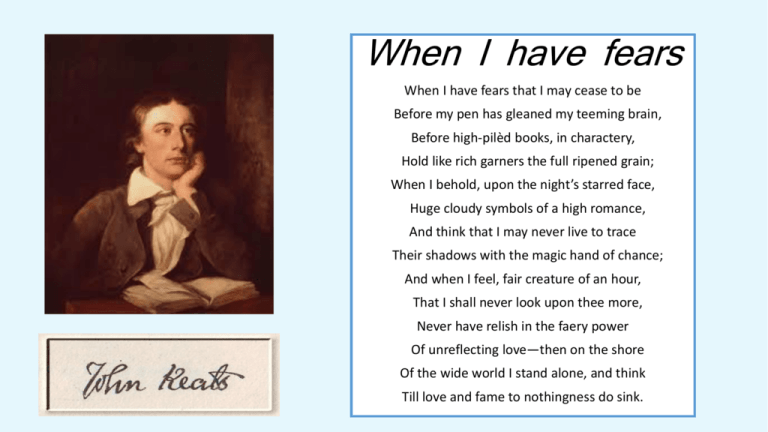
When I have fears When I have fears that I may cease to be Before my pen has gleaned my teeming brain, Before high-pilèd books, in charactery, Hold like rich garners the full ripened grain; When I behold, upon the night’s starred face, Huge cloudy symbols of a high romance, And think that I may never live to trace Their shadows with the magic hand of chance; And when I feel, fair creature of an hour, That I shall never look upon thee more, Never have relish in the faery power Of unreflecting love—then on the shore Of the wide world I stand alone, and think Till love and fame to nothingness do sink. Biographical Note: John Keats was born October 31st, 1795 in central London. In 1804, at the age of 9 his father died. At the age of 14, his mother died from Tuberculosis. He studied medicine and although he never practiced medicine, he nursed both his mother and brother through TB, from which they both died. He later learnt through his interactions with his brother, that he too contracted the illness. Not surprising that mortality is one of his common themes in his poetry. He became unofficially engaged to Fanny Brawne, who nursed him before he left England for Italy in an attempt to regain his health. He died in Italy in 1821, at the age of 26. Romantic Movement Keats, together with other contemporaries such as Wordsworth and others, are regarded as Romantic Poets. Keats formed part of the second generation. The Romantic era ranged from the 18th century to the mid-19th century. The poetry focussed on the creative expression, the use of imagination, the expression of the poet’s feelings and opinions and most importantly focused on striving to reach oneness with nature. Glossar y Line 2 gleaned – gathered the last bits of the grain after harvest Teeming – full, overcrowded with, bursting with Line 3 charactery – the physical act of writing, marks on paper, handwriting Line 4 garners – barns to hold grain Line 6 romance – imagination, an idealized, surreal mood Line 7 trace – write or draw Line 11 faery – fairy, magic Line 12 Unreflecting – unrequited Form and Elizabethan / Shakespearean Sonnet Structure Three quatrains and a rhyming couplet: abab cdcd efef gg - Each quatrain discusses one of Keats’ overwhelming fears. These three concerns are separated using semi-colons at the end of each line. The rhyming couplet contains his “answer” that qualifies all the “when” statements. - The poem is actually one long sentence. Each quatrain begins with an adverbial clause of time (“When I have fears”, “When I behold”, “And when I feel”) and the main clause containing the explanation (“then… I stand alone, and think”), is at the end. This clever structure creates tension and suspense. The first desire, discussed in first quatrain , is being able to write down all the poetry with which his brain is teeming. Euphemism: dying When I have fears that I may cease to be Start of sustained metaphor: “gleaned” means picking up the last bits of grain. Before my pen has gleaned my teeming brain, His poetry will fill many books Full, overcrowded Before high-pilèd books, in charactery, Pun: (1) handwriting (2) poet reveals parts of character through his poetry Sustained metaphor: He wonders Grain stores, barns to store grains, granary whether his pen will have chance to simile reap the rich harvest of poetry with Hold like rich garners the full ripened grain; which his brain is teeming. He compares the ideas in his brain with a field of grain, which he hopes will have time to ripen and be harvested, and he compares his books in which he will write down his poetry with a granary. (simile) The second desire, is based on the observation of nature and appreciation thereof. Here Keats identifies himself with the Romantic Movement. Personification: Compares the stars in the night sky to a beautiful face When I behold, upon the night’s starred face, Billowing clouds suggestive of imagination: nature endless source of creative inspiration. Huge cloudy symbols of a high romance, Identifies himself with Romantic Movement; also implying appreciation of nature’s beauty And think that I may never live to trace Their shadows with the magic hand of chance; He is reminded of death when he realises he may not be able write down ‘trace’ all he sees in nature. The hand that writes the poem, he regards the creative gift as magical, given randomly, wherever God or nature decides to place it. The third of the desires: to be able to look upon and admire the beauty of a womanto love her and engage in her beauty Beautiful woman – he loves a beautiful woman and wants to savour in her beauty even for a brief hour (reminds one of the final hour : mortality)c And when I feel, fair creature of an hour, Not having the chance to look at her beauty That I shall never look upon thee more, indulge ‘magical’ power. Possibly the power of love or referring to the power a woman has Never have relish in the faery power Unrequited love – not returned. Keats is content with loving her and admiring her beauty even if she does not feel the same or may not even know Of unreflecting love—then on the shore Dash – introduces the climax of the poem Start of main clause. Also, break for couplet happens mid-line 12 SIDE NOTE: Shelly have been recorded saying that Keats had a highly developed aesthetic sense and was always moved by beauty. He was happy to be able to respond to beauty by only observing it. When he thinks about not living long enough to be famous or to experience a great love, he realises one great truth: when he contemplates mortality, one stands Sea Imagery: “shore” “sink” – in which life is compared with entirely alone. the land, dying with the shore, and death with the sea, under which everything sinks to nothingness Of unreflecting love—then on the shore Alliteration: the long w-sounds emphasises the vastness of eternity and contrasts with the short of time Keats senses he has to live life. Of the wide world I stand alone, and think Till love and fame to nothingness do sink. Then all one’s desires for fame and love sink to nothingness beneath the sea of that one fact – that one has to die, and die alone. Long vowel sounds slows down the pace of the poem and helps to create a mood loneliness and emptiness. (Assonance) Themes: - Mortality - Artistic creativity - Preoccupation with time Tone in last two lines - Melancholic/regretful/ despairing since he is completely alone in death and knows he will lose all the opportunities and experiences he had hoped to have. - OR - Hopeful, triumphant because he realises that his spiritual gift has lasting value and that the earthly values of love and fame are far less important as they are meaningless. Note: Listen to an analysis of When I have Fears
